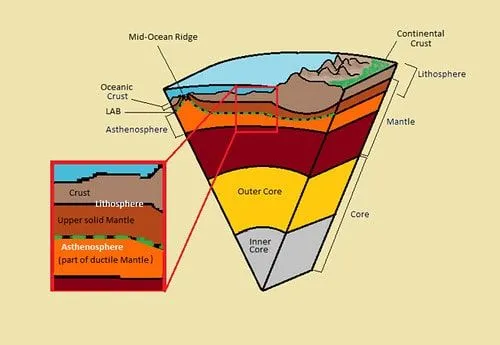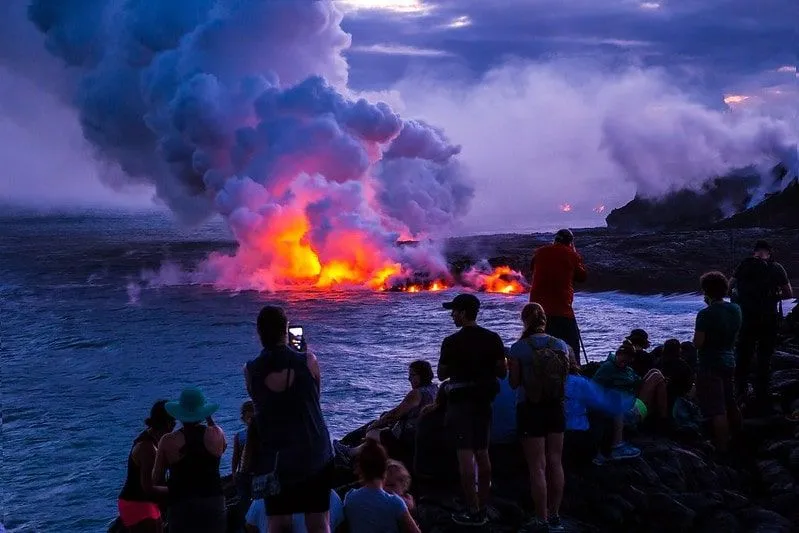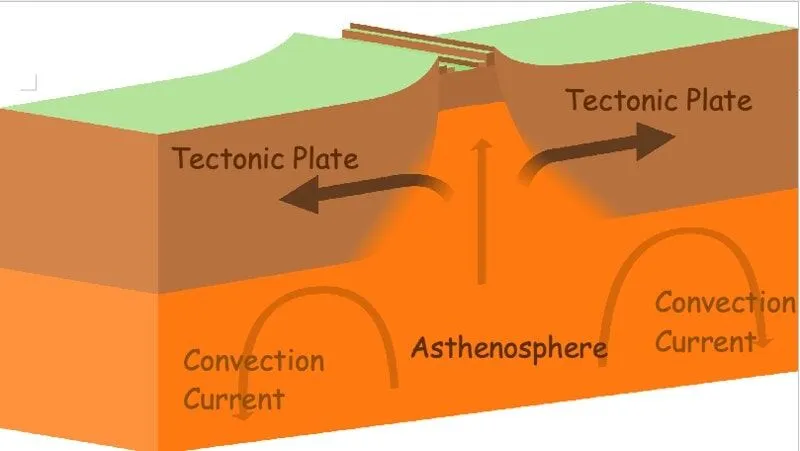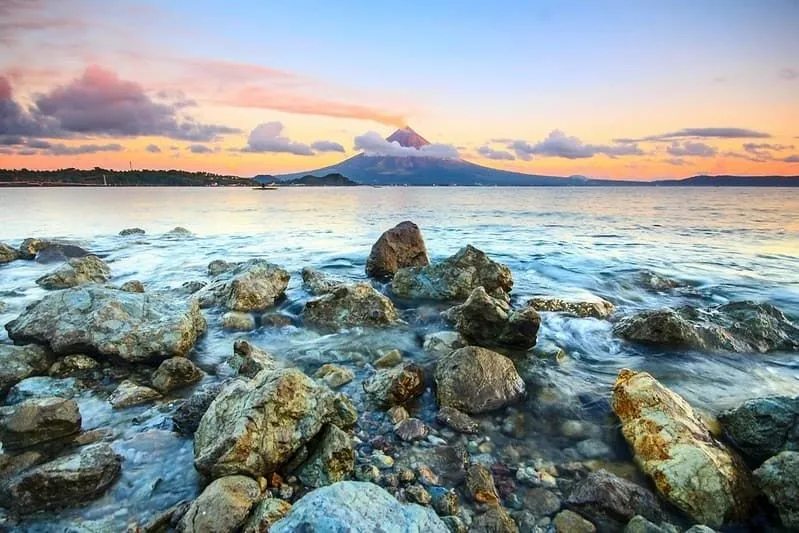FOR AGES 9 YEARS TO 11 YEARS
Image © Julia M. Cameron
Science can tell us so many incredible things about the way the Earth works, from how plants grow to why the sun rises, and even how earthquakes happen.
Most of us have heard of the Earth's core, and even the atmosphere, but what on earth is the asthenosphere? The asthenosphere is a layer of rock beneath the Earth's crust, where the Earth's solid crust and rocky upper mantle, or lithosphere, meet the lower layers of the mantle.
You might already know the Earth is made of layers, like an onion. On the outside is the crust, a thin layer of solid rock covering the Earth's surface. Along with the upper mantle, the crust forms a layer called the lithosphere. Below the crust is the mantle. The mantle is a thick rocky layer almost 3000km deep that makes up most of the Earth's volume. Deep beneath the mantle, at the centre of the earth, is the core, made of the densest and heaviest materials on earth.
Between the lithosphere and the lower mantle lies the asthenosphere, an amazing place where rock flows like liquid and waves slow down to a crawl. Below, we've listed ten amazing asthenosphere facts to fascinate your friends and family.

© Nealey S., under a Creative Commons license.
Before we can learn everything important about the asthenosphere, we need to know exactly what it is! The asthenosphere is a layer of rock that is found underneath the crust of the Earth. The solid crust of the Earth and its rocky upper mantle (also known as the lithosphere) meet the lower layers of the mantle at the asthenosphere, making it an important part of the structure of the Earth.
You'll have to put on your scientist hat to get to the core of these intriguing asthenosphere facts.
1) The asthenosphere is a layer of semi-molten rock. The temperature is just below the melting point of rock, so it's too hot to be solid like the crust, but still too cool to be liquid. It's also under a huge amount of pressure, so it has all kinds of strange properties. It can flow like a liquid, break like a solid and transmits seismic waves at different rates to the other layers. It may even be responsible for earthquakes and volcanoes!
2) The asthenosphere sits beneath the lithosphere (the solid outer layer that forms the Earth's surface), and forms part of the upper mantle. This can be anywhere between 100 km and 700 km beneath the Earth's surface. Whether or not a bit of rock counts as part of the asthenosphere is decided by its temperature. To count as part of the asthenosphere, the rocks' temperature has to have reached at least 1300°C.

3) The asthenosphere was discovered and named by a British geologist (a scientist who studies rocks) called Joseph Barrell in 1914. He divided the Earth into the lithosphere (the solid rocky bit on the outside), the asthenosphere and the centrosphere (the molten rock inside).
4) Although Joseph Barrell worked out that the asthenosphere must exist in 1914, we didn't prove it was there until 1960, when an enormous earthquake hit Chile. The seismic waves created by the earthquake were so strong that scientists were able to measure them closely and prove that they moved differently through the asthenosphere than in other layers of the Earth.
5) The name asthenosphere comes from the Greek word asthenia, meaning weak. Barrell called it the asthenosphere because its materials are weak compared to the more solid rocks in the lithosphere.
6)The asthenosphere is the reason plate tectonics work. Tectonic plates are large pieces of rock that make up the surface of the earth, a bit like puzzle pieces. They float on top of the asthenosphere. Because the asthenosphere is not completely solid, convection currents within it move each plate at a slightly different rate and direction. When a plate bumps into or slides along another plate, it causes shock waves, also called seismic waves. This movement is usually felt on the Earth's surface as an earthquake.

©domdomegg, under a Creative Commons license.
7) Scientists can measure how thick the asthenosphere is by measuring seismic waves. Yes, the same ones that cause earthquakes. Because the rocks in the asthenosphere are half-liquid and half-solid, waves called s-waves travel through it more slowly than they do other layers. By measuring how fast s-waves move, scientists can tell how deep the asthenosphere goes at different points round the earth.
8) The asthenosphere is also one reason we have volcanoes. If one tectonic plate starts to move away from another as they float on the asthenosphere, the movement can lead to a gap in the earth's crust, where magma bubbles up from below. This usually happens in the oceanic lithosphere (the bits of the lithosphere that are under the oceans). When one tectonic plate pulls away from another deep below the ocean, the cold seawater cools the magma to form new volcanic rocks on the seabed.

©Sidney Recato
9) The asthenosphere is closest to the surface of the earth under the oceans. This is because the rocks making up the lithosphere are thinner here, so there is less rock between the asthenosphere and the surface.
10) The place where the lithosphere meets the asthenosphere is called the LAB. We know it sounds like a science joke, but it really isn't. LAB stands for Lithosphere-Asthenosphere Boundary, and it means the place where the solid rocks of the lithosphere meet the semi-molten rocks of the asthenosphere.
Read The Disclaimer
At Kidadl we pride ourselves on offering families original ideas to make the most of time spent together at home or out and about, wherever you are in the world. We strive to recommend the very best things that are suggested by our community and are things we would do ourselves - our aim is to be the trusted friend to parents.
We try our very best, but cannot guarantee perfection. We will always aim to give you accurate information at the date of publication - however, information does change, so it’s important you do your own research, double-check and make the decision that is right for your family.
Kidadl provides inspiration to entertain and educate your children. We recognise that not all activities and ideas are appropriate and suitable for all children and families or in all circumstances. Our recommended activities are based on age but these are a guide. We recommend that these ideas are used as inspiration, that ideas are undertaken with appropriate adult supervision, and that each adult uses their own discretion and knowledge of their children to consider the safety and suitability.
Kidadl cannot accept liability for the execution of these ideas, and parental supervision is advised at all times, as safety is paramount. Anyone using the information provided by Kidadl does so at their own risk and we can not accept liability if things go wrong.
Kidadl is independent and to make our service free to you the reader we are supported by advertising.
We hope you love our recommendations for products and services! What we suggest is selected independently by the Kidadl team. If you purchase using the buy now button we may earn a small commission. This does not influence our choices. Please note: prices are correct and items are available at the time the article was published.
Kidadl has a number of affiliate partners that we work with including Amazon. Please note that Kidadl is a participant in the Amazon Services LLC Associates Program, an affiliate advertising program designed to provide a means for sites to earn advertising fees by advertising and linking to amazon.
We also link to other websites, but are not responsible for their content.
Was this article helpful?



Browse Category

We’ll send you tons of inspiration to help you find a hidden gem in your local area or plan a big day out.



Check your inbox for your latest news from us. You have subscribed to:
Remember that you can always manage your preferences or unsubscribe through the link at the foot of each newsletter.